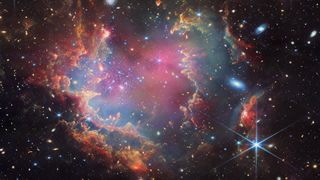
(Image credit: ESA/Webb, NASA & CSA, P. Zeidler, E. Sabbi, A. Nota, M. Zamani (ESA/Webb))
Astronomers using the James Webb Space Telescope (JWST) have peeked over the Milky Way‘s back fence and found that there’s something strange about the stellar infants playing next door.
While zooming in on the young star cluster NGC 602 in the nearby Small Magellanic Cloud (SMC), the researchers spotted what may be the first evidence of brown dwarfs ever seen outside the Milky Way. Brown dwarfs, or “failed stars,” are peculiar objects that are bigger than the largest planets but not massive enough to sustain nuclear fusion like stars.
The observations, which include a stunning new image of the star cluster courtesy of JWST’s Near Infrared Camera, reveal fresh insight into how these strange failed stars form. The team published its research Oct. 23 in The Astrophysical Journal.
“Brown dwarfs seem to form in the same way as stars, they just don’t capture enough mass to become a fully fledged star,” lead study author Peter Zeidler, a researcher at the European Space Agency (ESA), said in a statement. “Our results fit well with this theory.”
NGC 602 is a roughly 3 million-year-old star-forming cluster on the outskirts of the SMC, a satellite galaxy of the Milky Way that contains roughly 3 billion stars. (Our galaxy, in comparison, contains an estimated 100 billion to 400 billion stars.) Orbiting about 200,000 light-years from Earth, the SMC is one of the Milky Way’s closest intergalactic neighbors and a frequent target for astronomical studies.
Related: Runaway ‘failed star’ races through the cosmos at 1.2 million mph
Previous observations of NGC 602 taken with the Hubble Space Telescope revealed that the cluster hosts a population of young, low-mass stars. Now, thanks to JWST’s incredible sensitivity to infrared light, astronomers have fleshed out the picture of these stellar newborns, revealing precisely how much mass they have accumulated in their short lives.
The results suggest that 64 stellar objects within the cluster have masses ranging between 50 and 84 times that of Jupiter. Brown dwarfs typically weigh between 13 and 75 Jupiter masses, according to ESA — making many of these objects prime candidates to be the first brown dwarfs spotted beyond our galaxy.
These failed stars appear to have formed in much the same way as stars like the sun: through the collapse of massive clouds of gas and dust. However, for a collapsed cloud to become a star, it must continue accumulating mass until it reaches an internal temperature and pressure high enough to trigger hydrogen fusion at its core — combining hydrogen atoms into helium and releasing energy as light and heat in the process.
Brown dwarfs never acquire enough mass to sustain permanent fusion, leaving them larger than a planet but smaller and dimmer than a star. This failure to ignite may be a common outcome in the universe: Astronomers have discovered about 3,000 brown dwarfs in the Milky Way but estimate that there may be as many as 100 billion in our galaxy alone, potentially making them as common as stars themselves.
Studying this group of extragalactic failed stars further could help clarify why so many stars seemingly fail to ignite. But according to the researchers, these oddball objects could also reveal new insights about the early universe. NGC 602 is a young cluster containing low abundances of elements heavier than hydrogen and helium, so its composition is thought to be very similar to that of the ancient universe, before later generations of stars peppered the cosmos with the panoply of elements we see near Earth.
“By studying the young metal-poor brown dwarfs newly discovered in NGC 602, we are getting closer to unlocking the secrets of how stars and planets formed in the harsh conditions of the early Universe,” study co-author Elena Sabbi, a scientist at the National Science Foundation’s NOIRLab, the University of Arizona and the Space Telescope Science Institute, said in a second statement.
Note: This article have been indexed to our site. We do not claim legitimacy, ownership or copyright of any of the content above. To see the article at original source Click Here













